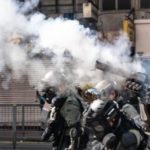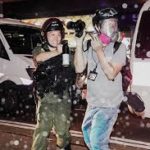Tiananmen 31 Years Later – Where Are We Now?
 This Thursday marks the 31st anniversary of the Chinese government’s violent crackdown on the peaceful protests at Tiananmen Square. On the night of June 3 and into the early morning hours of June 4, 1989, tanks rolled in to the streets of Beijing and the Chinese government did the unthinkable: it opened fire on its own people, killing hundreds if not thousands of unarmed civilians in the streets surrounding Tiananmen Square. That violent crackdown marked the end of student-led, peaceful protests in the Square, protests that sought to bring reform to China.
This Thursday marks the 31st anniversary of the Chinese government’s violent crackdown on the peaceful protests at Tiananmen Square. On the night of June 3 and into the early morning hours of June 4, 1989, tanks rolled in to the streets of Beijing and the Chinese government did the unthinkable: it opened fire on its own people, killing hundreds if not thousands of unarmed civilians in the streets surrounding Tiananmen Square. That violent crackdown marked the end of student-led, peaceful protests in the Square, protests that sought to bring reform to China.
To mark this anniversary, I was going to write a post on where China is today and its new attempts to squelch any dissent, protest, or rule of law in one of the last areas in China that permits freedom of speech: Hong Kong. But as I sit here in New York City, on a picture-perfect spring afternoon, searching for photos of the tanks rolling into the Tiananmen Square area to accompany the blog post, my twitter feed is full of pictures of U.S. military trucks invading some of America’s largest cities to “put down” peaceful – and some less peaceful – protests. These protests erupted soon after videos emerged of the brutal death of George Floyd, a black man who died after a white police officer pressed his knee into Floyd’s neck until Floyd stopped breathing. For eight minutes and 46 seconds, and even after Floyd’s handcuffed body went limp, the officer never stopped his pressure on Floyd’s neck. Three other police officers stood there and watched.
As protests erupt in the United States, our initial response is violence. Tear gas and pepper spray fill the streets of many U.S. cities with the police resorting to heavy-handed tactics. Peaceful protesters are hit with rubber bullets. There is little attempt by the police to de-escalate. Journalists find themselves the targets of police. The government blames “antifa” forces for instigating the protests. These scenes conjure up images of last year’s protests in Hong Kong, where violent police tactics were used against unarmed protesters. And with some Hong Kong protesters’ frustrations growing, they too sought to vandalize stores and destroy property. The Chinese government blames “foreign forces” for riling up the people. The one difference: President Xi Jinping didn’t tweet that the Hong Kong police should shoot the protesters; that would be too reminiscent of 1989. But, in the United States, President Donald Trump did tweet such sentiments. And mere days from the 31st anniversary of the Chinese government unleashing its military to massacre unarmed civilians, Trump has threatened to do the same.
- Beijing, June 1989
- US, May 2020
- Hong Kong, 2019
- US, May 2020
- Hong Kong, 2019
- US, May 2020
- Journalists attacked at the Hong Kong protests, 2019
- Journalists attacked during US protests, May 2020
- Hong Kong, 2019
- US, May 2020
- Hong Kong, 2019
- US, May 2020
I know that substantively comparing the United States and China is inappropriate. The police officer who killed Floyd has been charged with third degree murder and will be prosecuted at a public trial that will be covered by the press. The officer’s fate will be determined by an independent judicial system. These things would never happen in China, and increasing less so in Hong Kong. And there are some police officers and national guard members showing restraint and solidarity with the protesters; those who are not will be held accountable. Again, something that would not happen in China and isn’t happening in Hong Kong. But the images from the United States this week, and the sentiments from the U.S. president, are eerily similar to images of Beijing in 1989 and Hong Kong last summer. It’s too much to ignore. And I fear that like the protesters in 1989 who sought a better society for China, the protesters this weekend in the United States will confront a government that prevents them from realizing a better society for us: one that is truly equal and where black lives matter.
 Every year, I dedicate this post to those killed on June 4th, 1989. But as I write this, I wonder, how many of the men and women who lost their lives in Beijing 31 years ago used their last breathes to cry out for their mothers, just like George Floyd did last week on the streets of Minneapolis. And while we still must remember June 4th, the lives lost and the dreams crushed, this year, I would like to dedicate this post to George Floyd. And to Ahmaud Arbery, Breonna Taylor, Philando Castile, Sandra Bland, Eric Gardener, Michael Brown, Tamir Rice, Trayvon Martin and the countless other African Americans killed by the police in the United States (or people who thought they were the police). We need to say their names. We must never forget. For them, we must continue to build a better society with freedom, equality and dignity for all.
Every year, I dedicate this post to those killed on June 4th, 1989. But as I write this, I wonder, how many of the men and women who lost their lives in Beijing 31 years ago used their last breathes to cry out for their mothers, just like George Floyd did last week on the streets of Minneapolis. And while we still must remember June 4th, the lives lost and the dreams crushed, this year, I would like to dedicate this post to George Floyd. And to Ahmaud Arbery, Breonna Taylor, Philando Castile, Sandra Bland, Eric Gardener, Michael Brown, Tamir Rice, Trayvon Martin and the countless other African Americans killed by the police in the United States (or people who thought they were the police). We need to say their names. We must never forget. For them, we must continue to build a better society with freedom, equality and dignity for all.
- George Floyd
- Ahmaud Arbery
- Breonna Taylor
- Philando Castile
- Sandra Bland
- Eric Gardner with his wife Esaw
- Michael Brown
- Tamir Rice
- Trayvon Martin
 On Facebook
On Facebook By Email
By Email 





















There were two groups protesting against the gov. The students and the pro-communist workers yet the western media clearly has agended bias when they narrowly talk about the pro democracy students like Chai Ling and very rarely talk about the pro-communist workers who opposed Deng and died in large numbers that day.
And according to Wikileaks, contrary to the popular promoted myth. China did not send soldiers to the square and kill all the students who refused to leave. Chai ling lied about that. Instead the remaining students all left peacefully and the real battle was 5km west of the square where BOTH soldiers and protesters(workers) clashed and fought and died., That story is not well explained at all out of sheer bias. So far after 31 years, ONLY one western article talks about Wikileaks that shows the chinese gov wasn’t lying when they said students at the square were allowed to leave without violence yet the misleading myth of a tianammen squae massacre is effectively what most westerners seem to assume happened.
https://www.japantimes.co.jp/opinion/2019/06/06/commentary/world-commentary/tiananmen-narrative-true/
Excellent work as always from the great China Law and Policy! This is now required reading for students at Pierce College in Los Angeles. Thank you!
Thank you for your support! Also, always happy to have guest bloggers, so if any of the students would like to get their thoughts out in the world, would love to do that!
“Chinese government’s violent crackdown on the peaceful protests at Tiananmen Square. “??
Come, come. This is 2020. We have the Internet now, so we know there was no violent crackdown on the peaceful protests at Tiananmen Square. To murder, en masse, children whose protests are justified and peaceful? Not a chance. Even the government-owned Beijing Daily headlined, “Only the Hard-Hearted Could Fail to Support these Brave Young Students”.
The government’s patience far exceeded Lee Kwan Yew’s, who said he’d ‘have killed 200,000’ in the Square if that was the cost of stability.
U.S. Ambassador Charles Freeman marveled, “I cannot conceive of any American government behaving with the ill-conceived restraint that the Zhao Ziyang administration did in China, allowing students to occupy zones that are the equivalent of the Washington National Mall and Times Square combined, while shutting down much of the Chinese government’s normal operations”.
The kids went home safely not because the guys inside were squeamish about blood (they’d killed millions in the war) but because of the anticipated difficulty of explaining to their wives why they’d thought it compellingly necessary to shoot their daughter early that morning because she’d been protesting against a tuition raise.
There was no massacre in Tiananmen Square. Ever. Even the late, great Nobel Laureate Liu Xiaobo, who led the demonstration and stayed to the end and waited to get arrested on principle (the other leaders fled country) said so. The Chinese government pardoned him specifically because he had steadfastly led the ‘no bloodshed’ faction in the Square and everyone testified to his leadership.
It’s not a secret in China, that’s for sure. Bill Clinton and the President of China debated Tiananmen Square on national TV for an hour.
The Columbia Journalism Review critiques coverage of Tiananmen:
http://www.cjr.org/behind_the_news/the_myth_of_tiananmen.php?page=all
US State Department’s cables at the time:
http://www.alternativeinsight.com/Tiananmen.html
The Massacre that Wasn’t: http://www.globalresearch.ca/what-really-happened-in-tiananmen-square-25-years-ago/5385528
Britain’s Daily Telegraph:
http://www.telegraph.co.uk/news/worldnews/wikileaks/8555142/Wikileaks-no-bloodshed-inside-Tiananmen-Square-cables-claim.htm
Australian prof. Greg Clark
http://www.gregoryclark.net/jt/page116/page116.html
We have known this for decades but it’s just too juicy to relinquish and too embarrassing to confess to. It’s propaganda whose most serious effect is, each time an instance is discovered, to weaken our trust in our media.